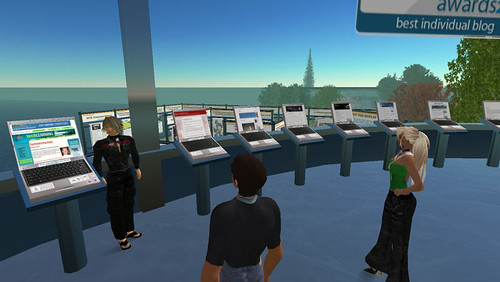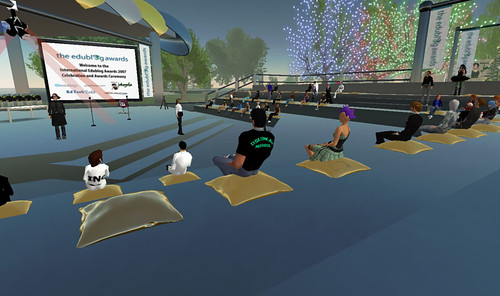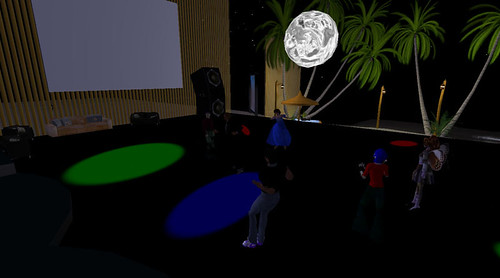A few posts ago I mentioned that both Betchablog and The Virtual Staffroom had been nominated for Eddies, or Edublog Awards.
As the voting processes started for the awards, there was apparently quite a bit of blog-love being shown for certain nominees in the form of multiple votes, automated voting, group voting, etc. It got to the point where the organisers had to first of all manually delete suspicious voting activity such as in the form of huge numbers of votes all coming from the same network address in a short period of time, and eventually had to completely limit the voting system to a single vote per IP address. No doubt this was the result of some very enthusiastic voting by students in class (“OK kids, your teacher has been nominated for an award so go to this url and click the button for me”). Finally, the opportunity to see the progress of the results was shut off completely as well. It’s a shame the voting had to be nobbled in this way as it really ruins whatever meaning may have been derived from the award process in the first place. At the end of the day, I think these awards are a bit of a lucky dip anyway and it was just nice to be nominated regardless of the notion of “winning”.
 What did intrigue me though was the notice I received to say that the awards ceremony would be held on Jokaydia Island. “Cool!” I thought, I get to fly off to some tropical resort on some exotic island somewhere to attend the ceremony. Well, it’s true, I did fly off, and it was an exotic island, but it existed only in the virtual world of Second Life. Yes, the Edublog Award ceremony was to be held in a virtual 3D space – a space existing only as a collection of bits, bytes and packets inside my computer, arranged into an amazing 3D environment by the creativity of the people who build these virtual spaces.
What did intrigue me though was the notice I received to say that the awards ceremony would be held on Jokaydia Island. “Cool!” I thought, I get to fly off to some tropical resort on some exotic island somewhere to attend the ceremony. Well, it’s true, I did fly off, and it was an exotic island, but it existed only in the virtual world of Second Life. Yes, the Edublog Award ceremony was to be held in a virtual 3D space – a space existing only as a collection of bits, bytes and packets inside my computer, arranged into an amazing 3D environment by the creativity of the people who build these virtual spaces.
While I have dabbled on and off with Second Life over the past year or so, I never spent long enough in there to really get my head around it. Holding the awards ceremony in SL was a great way to encourage me, and probably others, to spend a little more time in-world. So while I was dabbling again the other night I noticed Sue Waters was online in Skype. Sue, or Ruby Imako as she is known in-world, is well known for her Second Life skills so I buzzed her to ask for a quick tour of the facility. This turned out to be a really useful lesson, and I learned lots of things I’d not yet discovered, including how to get free stuff, how to make my audio work, how to interact with the in-world objects, and most important of all, how to photocopy my butt using the amazing Copybot. 🙂 Thanks to Ruby (Sue) and and also Slammed Aabye (Dean) for showing me around. It was enlightening, and made me realise just how much I have to learn.
 The actual awards were held on Sunday morning at 8:30am Sydney time so my SL alter-ego, Outback Outlander, turned up with a handsome new look (thanks to some last minute shopping on Freebie Island) and took my seat at the awards auditorium with a whole lot of other very good looking avatars. The event was hosted by Jeff Lebow, James Farmer and Dave Cormier who did a great job of keeping it all moving along despite a couple of minor hassles with the audio streams. Considering it was being broadcast out to Second Life, UStream and Skype, it was a pretty impressive undertaking. Here are a few happy snaps taken during the event, and these are the final winners. Also interesting to read is James Farmer’s insights into the “Awards Curve” and some suggestions for growing the event next year. Jo Kay, who is largely responsible for the creation of Jokaydia Island did an awesome job of building these spaces, and I’m absolutely gobsmacked at the world she has created in SL. Her attention to detail, sense of design, creativity and inventiveness just blows me away.
The actual awards were held on Sunday morning at 8:30am Sydney time so my SL alter-ego, Outback Outlander, turned up with a handsome new look (thanks to some last minute shopping on Freebie Island) and took my seat at the awards auditorium with a whole lot of other very good looking avatars. The event was hosted by Jeff Lebow, James Farmer and Dave Cormier who did a great job of keeping it all moving along despite a couple of minor hassles with the audio streams. Considering it was being broadcast out to Second Life, UStream and Skype, it was a pretty impressive undertaking. Here are a few happy snaps taken during the event, and these are the final winners. Also interesting to read is James Farmer’s insights into the “Awards Curve” and some suggestions for growing the event next year. Jo Kay, who is largely responsible for the creation of Jokaydia Island did an awesome job of building these spaces, and I’m absolutely gobsmacked at the world she has created in SL. Her attention to detail, sense of design, creativity and inventiveness just blows me away.
I’m still getting me head around Second Life. There are times when I see glimpses of amazing possibilities and others where I just shake my head and wonder what all the fuss is about. While it’s obviously got plenty of wow factor, I do still wonder just how effective the actual learning could be in a place like this. I still find it amazing that a virtual space can be used to hold an “event” like this, that people turn up, with their avatars all dressed up, some with virtual clothes that they paid for with real money, to socialise and mingle as though it were the real world. I still get blown away when I read that over half a million dollars of real money change hands in Second Life every day!
 When I told other people I know (who mostly don’t “get” this whole online world thing) that my blogs had been nominated for an award they congratulated me. When I told them the awards ceremony was going to held in a place that existed only inside a computer, populated by people who were represented only by virtual 3D characters, they looked at me as though I was nuts. When I heard people in-world saying that there was an awards after-party on the beach where there would be dancing and drinks, I started to wonder if I was nuts. Dancing and drinks?! C’mon! I mean, in my First Life I’m sitting in my study in front of my computer in my pyjamas on a Sunday morning and in my Second Life I’m heading to a virtual beach to drink virtual cocktails and dance under a virtual mirror ball? … I’m pretty geeky, but that is seriously bizarre stuff!
When I told other people I know (who mostly don’t “get” this whole online world thing) that my blogs had been nominated for an award they congratulated me. When I told them the awards ceremony was going to held in a place that existed only inside a computer, populated by people who were represented only by virtual 3D characters, they looked at me as though I was nuts. When I heard people in-world saying that there was an awards after-party on the beach where there would be dancing and drinks, I started to wonder if I was nuts. Dancing and drinks?! C’mon! I mean, in my First Life I’m sitting in my study in front of my computer in my pyjamas on a Sunday morning and in my Second Life I’m heading to a virtual beach to drink virtual cocktails and dance under a virtual mirror ball? … I’m pretty geeky, but that is seriously bizarre stuff!
So what did I do? I wandered down to the beach afterward and hit the dance floor with the others of course. Like most of this new technology world, if you ever want to understand it and find whatever value it might have, you just have to get in and give it a go. So pass me that virtual pina colada and let’s boogie on down, baby!

 On one of the several mailing lists I subscribe to, I saw a question from a network manager in another school asking for advice in dealing with some mistreatment of computer equipment by students. His proposed solution was to install webcams in the computer rooms and to stream their output to a server where it could be recorder and monitored. This person was asking for suggestions or advice from anyone else who had gone down this path.
On one of the several mailing lists I subscribe to, I saw a question from a network manager in another school asking for advice in dealing with some mistreatment of computer equipment by students. His proposed solution was to install webcams in the computer rooms and to stream their output to a server where it could be recorder and monitored. This person was asking for suggestions or advice from anyone else who had gone down this path.